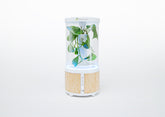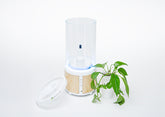FREE GROUND SHIPPING STORE WIDE
FAQ
A biophilic air purifier is an air purification system that combines technology with elements of biophilic design to not only clean the air but also create a more natural and harmonious indoor environment. Biophilic design is an approach that seeks to incorporate elements of nature into the built environment to improve well-being and connection to the natural world.
Here are the key features and concepts of a biophilic air purifier explained simply:
- Air Purification: Like a regular air purifier, a biophilic air purifier is designed to remove pollutants, allergens, and toxins from the indoor air. It uses filters and technology to clean the air, making it safer and healthier to breathe.
- Biophilic Design: What sets a biophilic air purifier apart is its design and features that mimic elements of nature. This can include the use of natural materials, colors, and patterns that evoke nature, such as wood finishes, earthy tones, or plant-inspired designs.
- Plants or Plant-Related Features: Many biophilic air purifiers incorporate live plants or features that mimic the presence of plants. Live plants can help improve air quality and add to the aesthetic appeal of the device.
- Visual and Aesthetic Appeal: Biophilic air purifiers are often designed to be visually pleasing and calming. They may have soft lighting, organic shapes, and natural textures that create a sense of tranquillity and connection to nature.
- Soundscapes: Some biophilic air purifiers include sound elements, such as gentle water sounds or birdsong, to further enhance the natural ambiance of the space.
- Positive Psychological Effects: The idea behind a biophilic air purifier is to promote well-being by reducing stress, improving mood, and increasing productivity through the incorporation of natural elements. This can contribute to a more pleasant and healthier indoor environment.
- Environmental Considerations: Biophilic air purifiers may prioritize sustainability and eco-friendliness in their design and materials, aligning with principles of environmental responsibility
In essence, a biophilic air purifier is not only functional in cleaning the air but also seeks to create a more nature-inspired and psychologically uplifting indoor atmosphere. It combines the benefits of air purification with elements of biophilic design to improve the overall quality of the indoor environment and enhance the well-being of occupants.
PM2.5, or "Particulate Matter 2.5," refers to tiny dust and dirt particles that are so small you can't see them with your naked eye. They are much tinier than a grain of sand, about 30 times smaller than the width of a human hair. These particles can float in the air.
PM2.5 is a kind of pollution that can be harmful to your health when you breathe it in because it can go deep into your lungs and even enter your bloodstream. It comes from things like car exhaust, factories, and even natural sources like dust and wildfires.
Breathing in too much PM2.5 can lead to problems like coughing, worsened asthma, and even heart and lung diseases. That's why it's essential for your health that the air you breathe has as little PM2.5 pollution as possible.
To protect your health, many places have rules and guidelines to limit how much PM2.5 pollution is allowed in the air. These rules help ensure that the air you breathe is cleaner and safer.
Volatile Organic Compounds (VOCs) are chemicals that can easily turn into gases or vapors at room temperature. These chemicals are often found in everyday products like paints, cleaning supplies, and even some furniture.
Here's a simple explanation:
Imagine you open a can of paint. You might notice a strong smell. That smell comes from VOCs. These are the chemicals in the paint that can evaporate into the air. When you breathe in the air with VOCs, it's like inhaling tiny bits of those chemicals.
Breathing in too many VOCs can be harmful to your health, causing problems like headaches, eye irritation, and even more severe issues if you're exposed for a long time.
That's why it's important to have good ventilation (fresh air coming in) when you're using products that contain VOCs, or to choose products with low or no VOCs when possible. In summary, VOCs are chemicals that can become gases in the air and are found in various products we use. They can affect indoor air quality and, if too many are inhaled, can have health effects
HEPA filtration in indoor air purification is like a super-efficient filter for cleaning the air you breathe inside buildings. It's designed to catch and trap tiny things in the air, like dust, pollen, and even germs.
Imagine it's like a net with super tiny holes. The holes are so small that these tiny things in the air, which can make you sick or cause allergies, get stuck in the net. So, when the air passes through this filter, it comes out much cleaner and safer for you to breathe.
In simple terms, HEPA filters are like superheroes for your indoor air, helping to keep it fresh and healthy.
Removing carbon dioxide (CO2) from indoor air is important for several reasons related to human health, comfort, and productivity. Here are some key reasons why removing CO2 from indoor air is beneficial:
- Improved Indoor Air Quality (IAQ): High levels of CO2 can indicate poor ventilation in indoor spaces. When people breathe out, they release CO2 into the air. Inadequate ventilation means that CO2 levels can build up, leading to stuffy air and a decrease in overall indoor air quality. Removing CO2 helps maintain a healthier indoor environment.
- Enhanced Cognitive Function: Elevated CO2 levels have been linked to impaired cognitive function, reduced decision-making abilities, and diminished concentration. By reducing CO2 concentrations, indoor air can promote better mental clarity and productivity.
- Better Comfort: High CO2 levels can contribute to feelings of discomfort, stuffiness, and fatigue. By removing excess CO2, indoor spaces become more pleasant and comfortable for occupants.
- Respiratory Health: While CO2 itself is not typically harmful at the concentrations found indoors, high CO2 levels are often associated with poor ventilation, which can lead to the accumulation of other pollutants like volatile organic compounds (VOCs) and airborne particles. These pollutants can adversely affect respiratory health. Removing CO2 by improving ventilation helps dilute and reduce the overall concentration of indoor pollutants.
- Sleep Quality: Poor indoor air quality, including high CO2 levels, can disrupt sleep patterns and lead to restless nights. Maintaining lower CO2 concentrations can contribute to better sleep quality.
- Health and Well-Being: Prolonged exposure to elevated CO2 levels may lead to symptoms like headaches, dizziness, and shortness of breath in some individuals. Ensuring lower CO2 concentrations supports the overall health and well-being of occupants.
- Energy Efficiency: Proper ventilation and CO2 control are essential in energy-efficient building design. Systems that efficiently remove excess CO2 while introducing fresh air can help reduce the energy required for heating or cooling, thus contributing to energy savings.
- Occupant Productivity and Performance: Studies have shown that better indoor air quality, including lower CO2 levels, can lead to increased productivity and improved performance in educational and workplace settings.
It's important to note that while removing CO2 from indoor air is essential for maintaining a healthy and comfortable indoor environment, the primary concern is ensuring adequate ventilation to prevent CO2 buildup in the first place. Proper ventilation systems, including the use of outdoor air and air exchange, are crucial for managing indoor CO2 levels effectively.
IAQ sensors, or Indoor Air Quality sensors, are devices used to monitor and measure the quality of air within indoor environments. These sensors detect various factors and pollutants in the air to assess and provide information about the indoor air's cleanliness and safety. IAQ sensors are essential for maintaining a healthy and comfortable indoor environment. Here are some common parameters that IAQ sensors can measure:
- Temperature: IAQ sensors often include temperature sensors to monitor the indoor temperature, ensuring it stays within a comfortable and safe range.
- Humidity: Humidity sensors measure the moisture level in the air. Maintaining appropriate humidity levels is crucial for comfort and preventing issues like mould growth.
- Carbon Dioxide (CO2): IAQ sensors can detect carbon dioxide levels in the air. Elevated CO2 levels can indicate poor ventilation and may affect indoor air quality and occupant comfort.
- Volatile Organic Compounds (VOCs): These sensors can identify the presence of volatile organic compounds, which are emitted from various sources like paints, cleaning products, and furniture. High VOC levels can contribute to poor indoor air quality.
- Particulate Matter (PM): IAQ sensors may measure the concentration of particulate matter in the air, including fine particles (PM2.5) and larger particles (PM10). High PM levels can be harmful to health.
Carbon Monoxide (CO): Some IAQ sensors are equipped with carbon monoxide detectors to alert occupants to the presence of this odourless but potentially deadly gas. - Radon: In areas prone to radon gas, specialised sensors can detect radon levels, which can be a significant health concern.
- Ozone (O3): Ozone sensors can detect the presence of ozone in indoor air. While ozone is beneficial in the upper atmosphere, ground-level ozone can be harmful when inhaled.
- Formaldehyde: IAQ sensors can measure formaldehyde levels, which can come from products like adhesives and furniture. High formaldehyde levels can irritate the eyes, nose, and throat.
IAQ sensors provide real-time data on these parameters, allowing building owners, occupants, and facility managers to make informed decisions about air quality management.
They are commonly used in residential, commercial, and industrial settings, as well as in specialised environments like hospitals and laboratories, where air quality is crucial for health, safety, and productivity. Monitoring and responding to IAQ data from these sensors can help maintain a healthier and more comfortable indoor environment.

A Canadian Company
@2025 Origen Air. All rights reserved.
- Choosing a selection results in a full page refresh.





